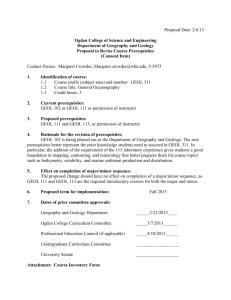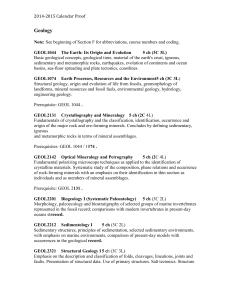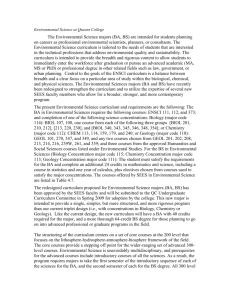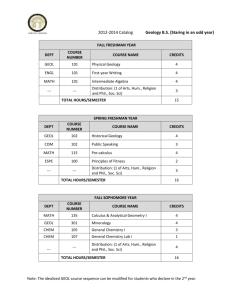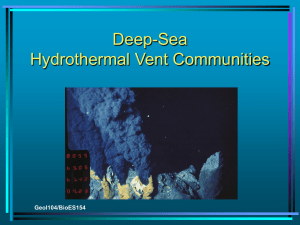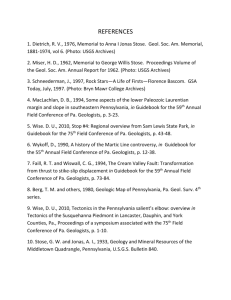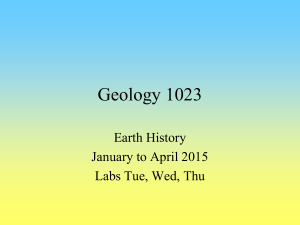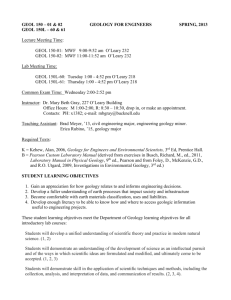proposed earth and space science teaching minor (3/27/2012)
advertisement
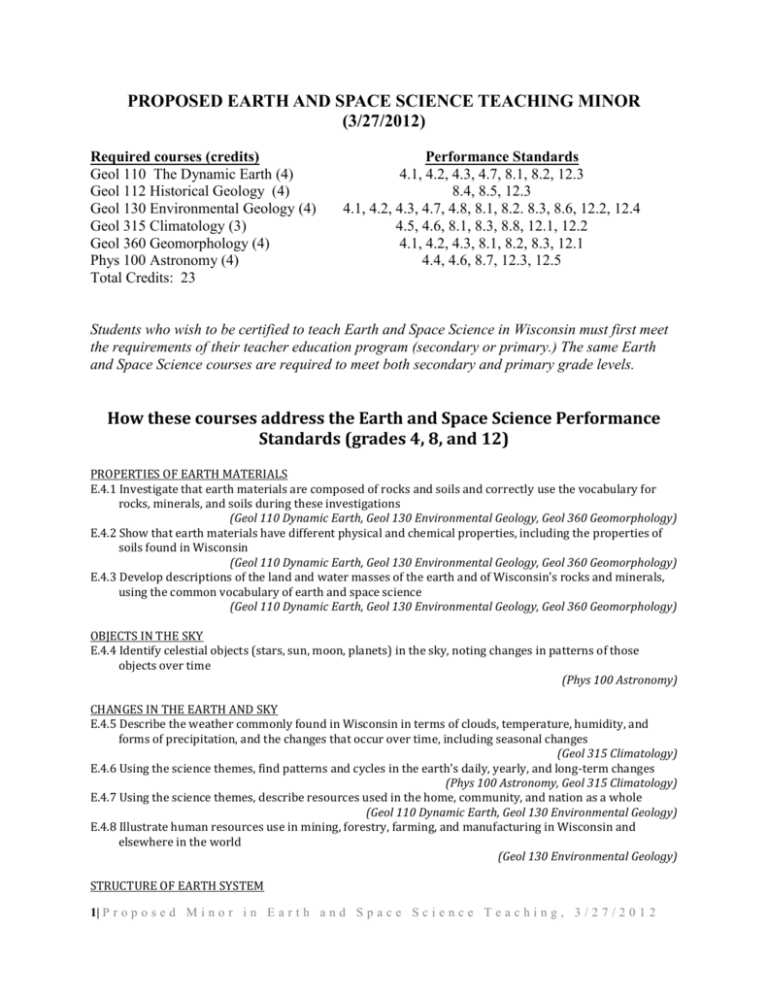
PROPOSED EARTH AND SPACE SCIENCE TEACHING MINOR (3/27/2012) Required courses (credits) Geol 110 The Dynamic Earth (4) Geol 112 Historical Geology (4) Geol 130 Environmental Geology (4) Geol 315 Climatology (3) Geol 360 Geomorphology (4) Phys 100 Astronomy (4) Total Credits: 23 Performance Standards 4.1, 4.2, 4.3, 4.7, 8.1, 8.2, 12.3 8.4, 8.5, 12.3 4.1, 4.2, 4.3, 4.7, 4.8, 8.1, 8.2. 8.3, 8.6, 12.2, 12.4 4.5, 4.6, 8.1, 8.3, 8.8, 12.1, 12.2 4.1, 4.2, 4.3, 8.1, 8.2, 8.3, 12.1 4.4, 4.6, 8.7, 12.3, 12.5 Students who wish to be certified to teach Earth and Space Science in Wisconsin must first meet the requirements of their teacher education program (secondary or primary.) The same Earth and Space Science courses are required to meet both secondary and primary grade levels. How these courses address the Earth and Space Science Performance Standards (grades 4, 8, and 12) PROPERTIES OF EARTH MATERIALS E.4.1 Investigate that earth materials are composed of rocks and soils and correctly use the vocabulary for rocks, minerals, and soils during these investigations (Geol 110 Dynamic Earth, Geol 130 Environmental Geology, Geol 360 Geomorphology) E.4.2 Show that earth materials have different physical and chemical properties, including the properties of soils found in Wisconsin (Geol 110 Dynamic Earth, Geol 130 Environmental Geology, Geol 360 Geomorphology) E.4.3 Develop descriptions of the land and water masses of the earth and of Wisconsin's rocks and minerals, using the common vocabulary of earth and space science (Geol 110 Dynamic Earth, Geol 130 Environmental Geology, Geol 360 Geomorphology) OBJECTS IN THE SKY E.4.4 Identify celestial objects (stars, sun, moon, planets) in the sky, noting changes in patterns of those objects over time (Phys 100 Astronomy) CHANGES IN THE EARTH AND SKY E.4.5 Describe the weather commonly found in Wisconsin in terms of clouds, temperature, humidity, and forms of precipitation, and the changes that occur over time, including seasonal changes (Geol 315 Climatology) E.4.6 Using the science themes, find patterns and cycles in the earth's daily, yearly, and long-term changes (Phys 100 Astronomy, Geol 315 Climatology) E.4.7 Using the science themes, describe resources used in the home, community, and nation as a whole (Geol 110 Dynamic Earth, Geol 130 Environmental Geology) E.4.8 Illustrate human resources use in mining, forestry, farming, and manufacturing in Wisconsin and elsewhere in the world (Geol 130 Environmental Geology) STRUCTURE OF EARTH SYSTEM 1| P r o p o s e d M i n o r i n E a r t h a n d S p a c e S c i e n c e T e a c h i n g , 3 / 2 7 / 2 0 1 2 E.8.1 Using the science themes, explain and predict changes in major features of land, water, and atmospheric systems (Geol 110 Dyn. Earth, Geol 130 Environmental Geology, Geol 315 Climatology, Geo 360 Geomorphology) E.8.2 Describe underlying structures of the earth that cause changes in the earth's surface (Geol 110 Dynamic Earth, Geol 130 Environmental Geology, Geol 360 Geomorphology) E.8.3 Using the science themes during the process of investigation, describe climate, weather, ocean currents, soil movements and changes in the forces acting on the earth (Geol 130 Environmental Geology, Geol 315 Climatology, Geol 360 Geomorphology) E.8.4 Using the science themes, analyze the influence living organisms have had on the earth's systems, including their impact on the composition of the atmosphere and the weathering of rocks (Geol 112 Historical Geology, Geol 315 Climatology) EARTH'S HISTORY E.8.5 Analyze the geologic and life history of the earth, including change over time, using various forms of scientific evidence (Geol 112 Historical Geology) E.8.6 Describe through investigations the use of the earth's resources by humans in both past and current cultures, particularly how changes in the resources used for the past 100 years are the basis for efforts to conserve and recycle renewable and non-renewable resources (Geol 130 Environmental Geology) EARTH IN THE SOLAR SYSTEM E.8.7 Describe the general structure of the solar system, galaxies, and the universe, explaining the nature of the evidence used to develop current models of the universe (Phys 100 Astronomy) E.8.8 Using past and current models of the structure of the solar system, explain the daily, monthly, yearly, and long-term cycles of the earth, citing evidence gained from personal observation as well as evidence used by scientists (Phys 100 Astronomy, Geol 315 Climatology) ENERGY IN THE EARTH SYSTEM E. 12.1 Using the science themes*, distinguish between internal energies* (decay of radioactive isotopes, gravity) and external energies (sun) in the earth's systems and show* how these sources of energy have an impact on those systems (Geol 315 Climatology, Geol 360 Geomorphology) GEOCHEMICAL CYCLES E.12.2 Analyze* the geochemical and physical cycles of the earth and use them to describe* movements of matter (Geol 130 Environmental Geology, Geol 315 Climatology) THE ORIGIN AND EVOLUTION OF THE EARTH SYSTEM E.12.3 Using the science themes*, describe* theories of the origins and evolution* of the universe and solar system, including the earth system* as a part of the solar system, and relate* these theories and their implications to geologic time on earth (Phys 100 Astronomy, Geol 110 Dynamic Earth, Geol 112 Historical Geology) E.12.4 Analyze* the benefits, costs, and limitations of past, present, and projected use of resources and technology and explain* the consequences to the environment (Geol 130 Environmental Geology) THE ORIGIN AND EVOLUTION OF THE UNIVERSE E.12.5 Using the science themes*, understand* that the origin of the universe is not completely understood, but that there are current ideas in science that attempt to explain its origin (Phys 100 Astronomy) 2| P r o p o s e d M i n o r i n E a r t h a n d S p a c e S c i e n c e T e a c h i n g , 3 / 2 7 / 2 0 1 2
